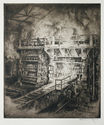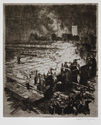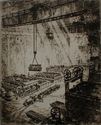
19th, 20th & 21st Century Fine Prints
707-546-7352 · fax 707-546-7924 · web: www.annexgalleries.com · email: artannex@aol.com
Otto August Kuhler Biography
Otto August Kuhler
American
1894–1976
Biography
Otto August Kuhler was born in Remscheid, Germany on July 31, 1894. Kuhler was the sole heir to his family's successful German steel business, Kuhler Forges, founded by his grandfather in 1782. He married Simmone Gillot in 1920, and lived in Dusseldorf where he studied engineering and art. His automobile body design sent in to Kathe & Soehne for a Mercedes chassis won a gold medal in 1913. Employed as a stylist with N.A.G. Berlin he designed movie sets for William Wauer's silent film "The Tunnel." He became associate editor of "Der Motor" magazine, and then styled car bodies for Snutsel Père & Fils (Brussels) and European automobile producers. After WWI however, the business and his family's fortune were in ruins so, partly due to the advice of a friend, American etcher Joseph Pennell, he took up etching and emigrated to the States in 1923, first to New York and then to the center of the U.S. steel industry, Pittsburgh, Pennsylvania.
He was able to eke out a modest living as an etcher after arriving in the United States and was able to bring Simmone over. Otto Kuhler's etchings of infrastructure and industry sprang from the same optimistic response to technology that led to his colorful streamlined designs of locomotives for the Milwaukee, Lehigh and other railroads in the 1930's. His prints bridge art and industry -- freely-sketched scenes that celebrate precise engineering and industrial might. This merging of industry and art proved so successful that after years of submitting designs, a locomotive based on Kuhler's designs was built. The engine, 'Hiawatha', rolled out of the Schenectady, New York yard in May, 1935. It was the first streamlined steam locomotive to be built from scratch in America. This signaled the start of the next phase of his career- as a successful industrial designer. These 'Hiawatha' trains became the fastest passenger service in the world by 1935. He had also designed the cars' interior, including the napkins and draperies in the dining car. His finned Beaver Tail observation car of the next generation was sensational, as were again the streamlined second-generation Milwaukee Road class F7 passenger locomotives designed by Kuhler. Also he designed the ALCO DL-109, the predecessor of world-famous ALCO PA diesel locomotives.
As art director of the B&O magazine Kuhler was instrumental in developing the blue and gray color scheme and the modernized herald of B&O. When B&O turned to streamlining its Washington-New York run Kuhler could finally establish his "bullet nose" design on a steam locomotive that became known as "Kuhler type". Otto August Kuhler died in Jefferson, Colorado on August 5, 1976.







